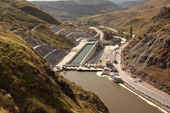
Opening of Paravani hydro-electric plant
By Tatia Megeneishvili
Monday, October 13
The HEPP was opened by Prime Minister of Georgia Irakli Garibashvili, Energy Minister Kakha Kaladze, and Turkey’s Minister of Energy and Natural Resources TanerYildiz.
According to Gharibashvili, an HEPP of similar strength has not been built in Georgia for the last 35 years.
“More than $200 million was invested in the construction of the plant, which is really a significant investment made by our Turkish partners. The interest of investors toward Georgian energy resources is continuing to grow and I am sure that the next project will strengthen the energy system of our country and help the growth of energy security in Georgia,” stated Gharibashvili.
Gharibashvili underlined that all decisions in the direction of assimilating energy resources are based on qualified analysts and the Georgian government will develop an energy sector without any gaps.
The plant is operated and owned by Georgia Urban Energy in which a Turkish conglomerate, the Anadolu Group, holds 90% of the share. The rest of the shares are owned by the European Bank of Reconstruction and Development (EBRD).
According to Bruno Balvanera, EBRD’s director for the Caucasus, Moldova and Belarus, the hydro power plant will supply electricity to Georgia during the winter and export it to Turkey during the other months.
“This power plant is a landmark project as the first private, large-scale renewable power generation project in Georgia, and one which will also have a cross-border dimension,” said Balvanera.
The Paravani HEPP is located between the settlements of Ahalkalaki and Khertvisi, about 30-40 km from the Turkish-Georgian border in the southeast of Ahaltsikhe. The facility is planned to have an annual total energy production of 450.7 GWh and an installed output of 85.8 MW having a net head of 390.70 m.
HEPP construction was launched in 2010. The development plan for the Paravani River took final shape early in the 1990’s upon conclusion of the studies by Hydroproekti, the scientific design institute, and was approved by the Ministry of Urbanization and Construction.


